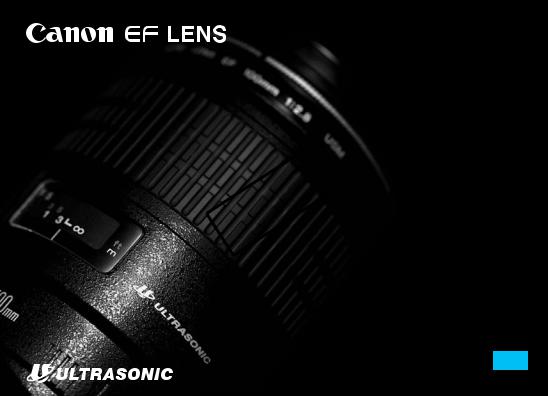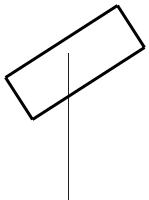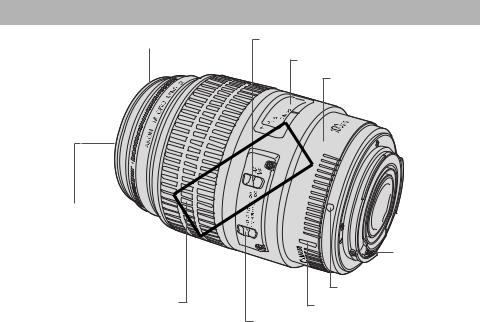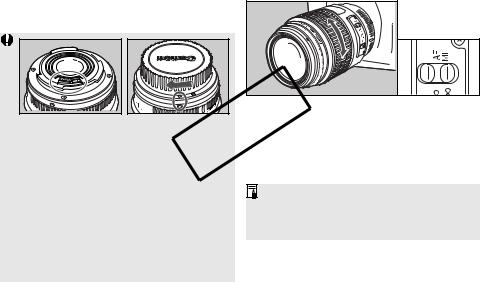Canon EF100MM User Manual

EF100mm f/2.8 MACRO USM
COPY
ENG
Instruction

Thank you for purchasing a Canon product.
Features
1. The three-group floating system results in excellent delineation at all focusing distances from life-size to infinity.
2. Ultrasonic motor (USM) for quick and quiet autofocusing.
COPY3. A Canon macro flash makes it easy to take close-up pictures with a flash. The inner focusing mechanism enables AF photography while the macro flash is attached.
Conventions used in this instruction
Warning to prevent lens or camera malfunction or damage.
Supplementary notes on using the lens and taking pictures.
ENG-1

|
|
|
|
|
|
|
|
|
This device complies with Part 15 of the FCC Rules. Operation is |
a Safety Precautions |
|
|
||
|
|
subject to the following two conditions: (1) This device may not |
||
• |
Do not look at the sun or a bright light source |
|
cause harmful interference, and (2) this device must accept any |
|
|
through the lens or camera. Doing so could result |
|
interference received, including interference that may cause |
|
|
in loss of vision. Looking at the sun directly through |
|
undesired operation. |
|
|
|
Do not make any changes or modifications to the equipment |
||
|
the lens is especially hazardous. |
|
|
|
|
|
|
unless otherwise specified in the instructions. If such changes or |
|
• |
Whether it is attached to the camera or not, do |
|
||
|
modifications should be made, you could be required to stop |
|||
|
not leave the lens under the sun without the |
|
||
|
|
operation of the equipment. |
||
|
lens cap attached. This is to prevent the lens from |
|
This equipment has been tested and found to comply with the |
|
|
concentrating the sun’s rays, which could cause a |
|
limits for a class B digital device, pursuant to part 15 of the FCC |
|
|
fire. |
|
|
Rules. These limits are designed to provide reasonable protection |
|
|
|
|
against harmful interference in a residential installation. This |
|
|
|
|
equipment generates, uses and can radiate radio frequency |
Handling Cautions |
|
|
energy and, if not installed and used in accordance with the |
|
• |
If the lens is taken from a cold environment into |
|
instructions, may cause harmful interference to radio |
|
|
communications. |
|||
|
a warm one, condensation may develop on the |
|
||
|
|
However, there is no guarantee that interference will not occur in |
||
|
lens surface and internal parts. To prevent |
|
||
|
|
a particular installation. If this equipment does cause harmful |
||
|
condensation in this case, first put the lens into an |
|
||
|
|
interference to radio or television reception, which can be |
||
|
|
COPY |
||
|
airtight plastic bag before taking it from a cold to |
|
determined by turning the equipment off and on, the user is |
|
|
warm environment. Then take out the lens after it |
|
encouraged to try to correct the interference by one or more of |
|
|
has warmed gradually. Do the same when taking |
|
the following measures: |
|
|
the lens from a warm environment into a cold one. |
|
• Reorient or relocate the receiving antenna. |
|
|
|
• Increase the separation between the equipment and receiver. |
||
• Do not leave the lens in excessive heat such as in |
|
|||
|
• Consult the dealer or an experienced radio/TV technician for |
|||
|
a car in direct sunlight. High temperatures can |
|
||
|
|
help. |
||
|
cause the lens to malfunction. |
|
|
|
|
|
|
|
|
|
|
|
This Class B digital apparatus complies with Canadian ICES-003. |
|
|
|
|
|
|
|
|
|
|
|
|
|
|
|
ENG-2 |

Nomenclature
Hood and Macro Ring Lite mount (→ 5, 11)
Focus mode switch (→ 4)
Distance scale (→ 8)
Tripod mounting location (→ 8)
Filter mounting thread (→ 10)

 COPY
COPY
Contacts (→ 4)
Lens mount index (→ 4)
Tripod mount adapter groove (→ 8) Focusing distance range selection switch (→ 5)
For detailed information, reference page numbers are provided in parentheses (→ **).
ENG-3

1. Mounting and |
|
2. Setting the Focus |
Detaching the Lens |
|
Mode |
See your camera’s instructions for details on mounting and detaching the lens.
|
To shoot in autofocus (AF) mode, set the focus |
|
• After detaching the lens, place the lens with the |
mode switch to AF. |
|
To use only manual focusing (MF), set the focus |
||
rear end up to prevent the lens surface and |
||
electrical contacts from getting scratched. |
mode switch to MF, and focus by turning the |
|
• If the contacts get soiled, scratched, or have |
focusing ring. The focusing ring always works, |
|
fingerprints on them, corrosion or faulty |
regardless of the focus mode. |
|
connections can result. The camera andClensOPY |
||
may not operate properly. |
After autofocusing in ONE SHOT AF mode, focus |
|
• If the contacts get soiled or have fingerprints on |
manually by pressing the shutter button halfway |
|
them, clean them with a soft cloth. |
and turning the focusing ring. (Full-time manual |
|
• If you remove the lens, cover it with the dust |
focus) |
|
cap. To attach it properly, align the lens mount |
|
|
index and the K index of the dust cap as shown |
|
|
in the diagram, and turn clockwise. To remove it, |
|
|
reverse the order. |
|
|
ENG-4
